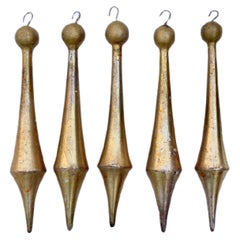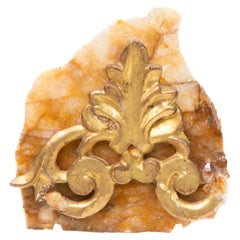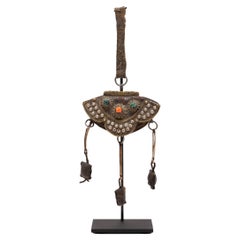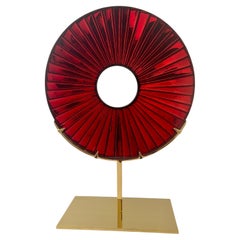Gold Mounted Objects
18th Century Italian Rococo Antique Gold Mounted Objects
Gold Leaf
18th Century Italian Rococo Antique Gold Mounted Objects
Quartz, Rock Crystal, Gold Leaf
Mid-19th Century Tibetan Tibetan Antique Gold Mounted Objects
Coral, Gold Plate, Steel, Metal
19th Century Italian Rococo Antique Gold Mounted Objects
Quartz, Rock Crystal, Gold Leaf
21st Century and Contemporary Italian Modern Gold Mounted Objects
Gold, Brass
18th Century Italian Rococo Antique Gold Mounted Objects
Crystal, Rock Crystal, Gold
17th Century Italian Baroque Antique Gold Mounted Objects
Rock Crystal, Quartz, Gold Plate, Gold Leaf, Metal
18th Century Italian Rococo Antique Gold Mounted Objects
Rock Crystal, Gold Leaf
18th Century Italian Rococo Antique Gold Mounted Objects
Rock Crystal, Crystal, Gold Leaf
18th Century Italian Rococo Antique Gold Mounted Objects
Crystal, Rock Crystal, Gold Leaf
21st Century and Contemporary Italian Modern Gold Mounted Objects
Gold, Brass
21st Century and Contemporary Italian Modern Gold Mounted Objects
Gold, Brass
18th Century Italian Rococo Antique Gold Mounted Objects
Quartz, Rock Crystal, Gold Leaf
18th Century Italian Rococo Antique Gold Mounted Objects
Agate, Coral, Gold Leaf
17th Century Italian Rococo Antique Gold Mounted Objects
Coral, Gold Leaf
18th Century Italian Rococo Antique Gold Mounted Objects
Rock Crystal, Coral, Gold Leaf
18th Century Italian Rococo Antique Gold Mounted Objects
Quartz, Rock Crystal, Gold Leaf
18th Century Italian Rococo Antique Gold Mounted Objects
Crystal, Rock Crystal, Gold Leaf
21st Century and Contemporary Italian Art Deco Gold Mounted Objects
Gold Leaf
18th Century Italian Baroque Antique Gold Mounted Objects
Rock Crystal, Gold Leaf, Metal
21st Century and Contemporary Moroccan Organic Modern Gold Mounted Objects
Rock Crystal, Gold Leaf
18th Century Italian Rococo Antique Gold Mounted Objects
Quartz, Rock Crystal, Gold Leaf
19th Century European Empire Antique Gold Mounted Objects
Alabaster, Gold Leaf
18th Century Italian Rococo Antique Gold Mounted Objects
Rock Crystal, Gold Leaf
18th Century Italian Rococo Antique Gold Mounted Objects
Quartz, Rock Crystal, Gold Leaf
1830s American American Empire Antique Gold Mounted Objects
Gold, Iron
18th Century Italian Rococo Antique Gold Mounted Objects
Rock Crystal, Gold Leaf
18th Century Italian Rococo Antique Gold Mounted Objects
Rock Crystal, Pyrite, Gold Leaf
18th Century Italian Rococo Antique Gold Mounted Objects
Agate, Coral, Gold Leaf
1990s Italian Mid-Century Modern Gold Mounted Objects
Gold Leaf
18th Century Italian Rococo Antique Gold Mounted Objects
Rock Crystal, Pyrite, Gold Leaf
18th Century Italian Rococo Antique Gold Mounted Objects
Rock Crystal, Pyrite, Gold Leaf
18th Century Italian Rococo Antique Gold Mounted Objects
Rock Crystal, Gold Leaf
18th Century Italian Rococo Antique Gold Mounted Objects
Rock Crystal, Gold Leaf
18th Century Italian Organic Modern Antique Gold Mounted Objects
Quartz, Rock Crystal, Gold Leaf
18th Century Brazilian Organic Modern Antique Gold Mounted Objects
Amethyst, Gold Leaf
1990s Italian Art Deco Gold Mounted Objects
Gold Leaf
18th Century Italian Rococo Antique Gold Mounted Objects
Quartz, Rock Crystal, Gold Leaf
21st Century and Contemporary Italian Gold Mounted Objects
Gold Plate, Steel
18th Century Italian Rococo Antique Gold Mounted Objects
Metal, Gold Leaf
18th Century Italian Rococo Antique Gold Mounted Objects
Rock Crystal, Gold Leaf
18th Century Italian Rococo Antique Gold Mounted Objects
Agate, Coral, Gold Leaf
18th Century Italian Rococo Antique Gold Mounted Objects
Quartz, Rock Crystal, Marble, Metal, Gold Leaf
18th Century Italian Rococo Antique Gold Mounted Objects
Gold Leaf
21st Century and Contemporary French Gold Mounted Objects
Gold
Late 19th Century Tibetan Antique Gold Mounted Objects
Gold
Early 20th Century Tibetan Tibetan Gold Mounted Objects
Gold Plate, Brass, Steel
18th Century Italian Rococo Antique Gold Mounted Objects
Gold Leaf
17th Century German Baroque Antique Gold Mounted Objects
Gold Leaf
18th Century Italian Rococo Antique Gold Mounted Objects
Agate, Coral, Gold Leaf
18th Century Spanish Baroque Antique Gold Mounted Objects
Gold Leaf
17th Century Italian Baroque Antique Gold Mounted Objects
Gold Leaf
Early 17th Century Italian Baroque Antique Gold Mounted Objects
Gold Leaf





